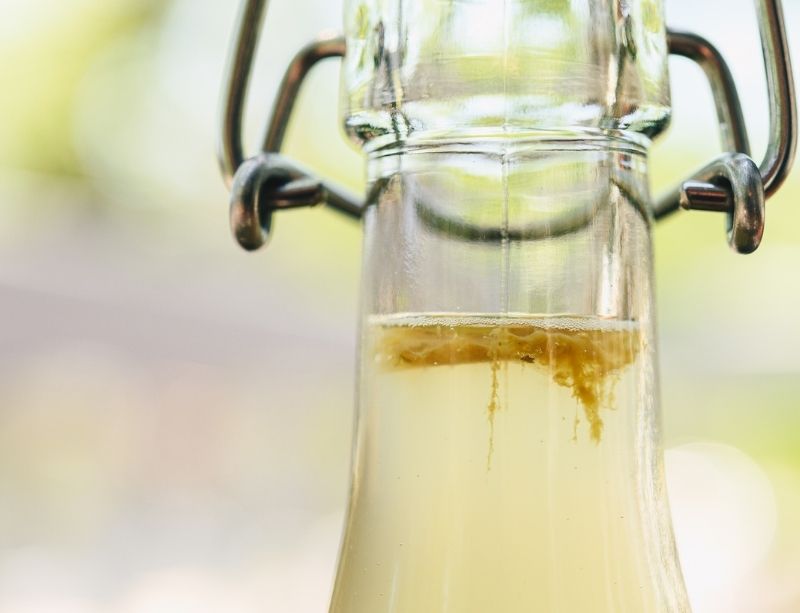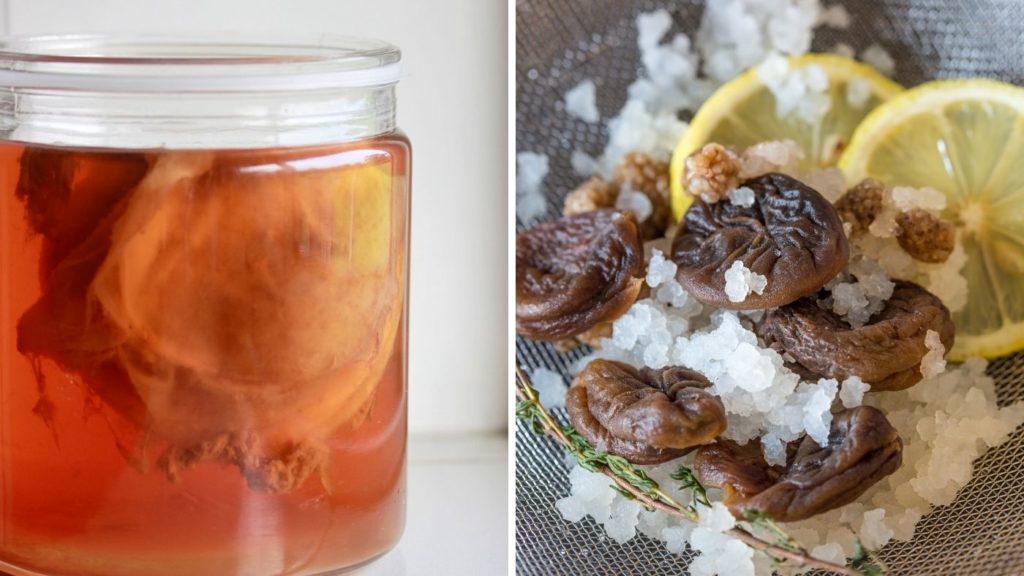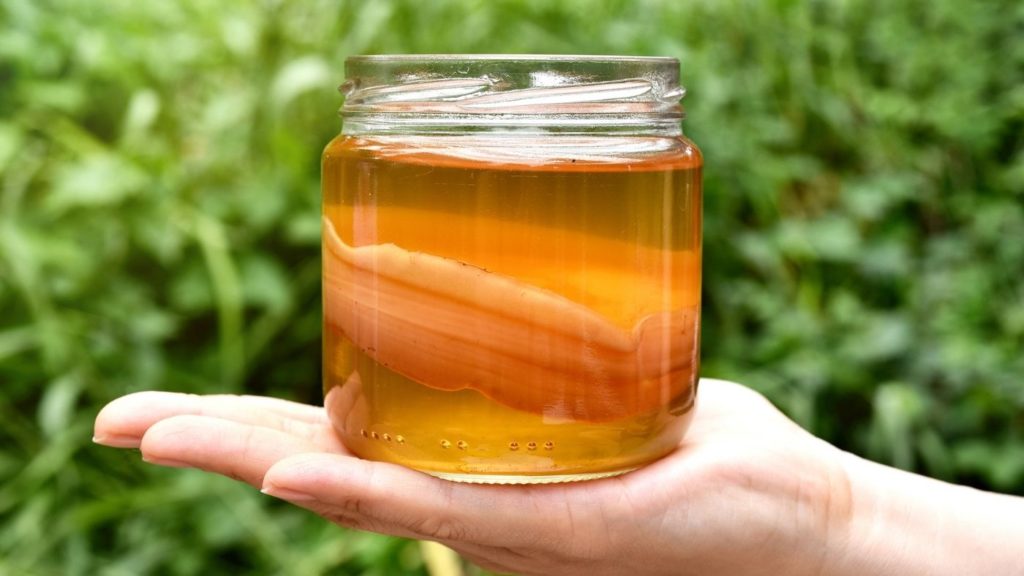When you start fermenting kombucha, it is normal to wonder if your kombucha scoby is healthy. Everything seems so strange!
You might be asking yourself:
“Is my kombucha scoby mouldy?”
“How does a healthy kombucha scoby looks like?”
“Are these black filaments mould?”
Don’t worry: 99% of the time, the kombucha scoby is perfectly healthy. It can appear in all sorts of shapes and forms. Indeed, a scoby is quite funky!
This article will help you identify what’s going on in your jar, so you know if your scoby (and your kombucha!) is doing well.
To find the answer to your question, click directly on the topic that interests you:
- Is My Kombucha Scoby Is Still Alive?
- My Kombucha Scoby Is Sinking
- White Layer on Top of My Kombucha
- Brown Stuff in My Kombucha
- New Scoby Forming in My Bottle
- Is the Colour of My Scoby Normal?
- My Kombucha Is Not Fizzy
- My Kombucha Is Too Acid
- Can Kombucha Be Dangerous?
- How Do I Know If My Scoby Is Dead?
- Why Did My Scoby Die?
- Is My Kombucha Scoby Mouldy Or Rotten?
- Maggots in My Kombucha
Identifying a Healthy Kombucha Scoby
Let’s face it – a kombucha scoby is a strange thing for the inexperienced! Indeed, this cellulose film created by symbiotic colonies of bacteria and yeast has a rather astonishing appearance.
It can take all sorts of shapes, colours, and behaviours. Fortunately, they are normal most of the time. You have to learn to appreciate your scoby, no matter how unique they may be!
This section gives you an overview of normal and healthy kombucha scobies, which is the case 99% of the time.
How Do I Know If My Kombucha Scoby Is Still Alive?
To find out if your kombucha scoby is doing well, just test it!
Make a normal kombucha recipe by adding the scoby to some sweet tea. Wait a week and observe.
Signs that everything is fine:
- A new scoby is forming on the surface/the scoby is getting bigger
- Your sweet tea has become tangy
- Small bubbles are forming
It is normal (especially at the beginning) for only one of these signs to appear.
The most important is that the tea becomes less sweet and more acidic.
Why is My Kombucha Scoby Sinking?
No worries, it’s normal! Young kombucha mothers tend to sink to the bottom of the jar.
You don’t have to do anything. A new film will gradually form on the surface.

For more information, read Why is my kombucha scoby sinking?
What Is the White Layer on Top of My Kombucha?
The white layer is a new scoby that has formed on the surface of your kombucha. Its appearance is often smooth.
The kombucha scoby covers the entire surface of the sweet tea to help protect it from external contaminants. Do not touch it!
It is perfectly normal; it will gradually thicken, and you can use it for your next kombucha recipe.
What Is the Brown Stuff in My Kombucha?
The small brown or black stringy clumps are colonies of yeast and tea residue. They are completely normal and safe!

These colonies often form long filaments that hang under the kombucha scoby.
Yeast can also merge with the existing layer, or even form in bottles after bottling. You can choose to remove them, or not.
A New Scoby Is Forming in My Bottle! Is This Normal?
Yes, even in the bottle, the microorganisms in kombucha are still at work.

The little scobies created in the bottles often merge with yeast colonies, resulting in small gelatinous layers or brown filaments, and sometimes both.
When this happens, it just means that your kombucha scoby is healthy and strong!
You can choose whether or not to filter your kombucha before you drink it. The layer is entirely edible and full of life.
Is the Colour of My Kombucha Scoby Normal?
The colour of the kombucha scoby is not important.
In practical terms, a kombucha scoby is like a sponge. The tea used will change the colour of the scoby: black tea will give a darker scoby, while green tea will give a lighter scoby.
There can also be different colours, tints, or parts within the same scoby. Once again, this is all perfectly normal.

Growing scoby: the different colours are due to the different thicknesses of the kombucha scoby.
My Kombucha Is Not Fizzy. Is My Scoby Dead?
No! Bubbles are not an indicator of your kombucha’s health. Several factors influence the amount of sparkling:
- The bottles used
- The ingredients
- The scoby’s age
- The temperature
And much more! To learn more about this, read How to Make Fizzy Kombucha.
What to Do If My Kombucha Is Too Acid?
You have left your kombucha to ferment too long, and it has become too acidic for your taste? Know that it is still safe to consume and full of good microorganisms.
You can dilute a kombucha that is too acidic with sweet tea or with a younger and therefore sweeter kombucha.
You can also let it turn into kombucha vinegar by fermenting it longer or use this kombucha as a starter culture for your next recipe.
Reduce the fermentation time of your kombucha next time!
Can Kombucha Be Dangerous to Health?
There is no danger in consuming kombucha because its acidity protects it from contamination.
Read: Are there any dangers to homemade kombucha?
If, however, fermentation has gone wrong and mould has formed or contamination has occurred, then yes, there may be a health risk (as with any food, for that matter). Read on to find out more.
Identifying Sick or Dead Kombucha Scoby
It is extremely rare for kombucha scobies to get sick, or even die. This section will help you identify these rare occurrences.
How Do I Know If My Kombucha Scoby Is Dead?
The only way to know if your kombucha scoby is dead is to test it in a new kombucha batch and wait a few weeks.
If your sweet tea has not become acidic after 15 days, then you can definitely conclude that your kombucha scoby has died.
Why Did My Kombucha Scoby Die?
Several situations can lead to the death of a kombucha scoby:
An Exhausted Scoby
A scoby can usually survive without being fed or oxygenated for:
- 6 months in the fridge
- 3 weeks at room temperature
Beyond this time, a scoby left in a closed jar or not fed with new sweet tea will eventually exhaust itself. It will lose its ability to produce kombucha. To learn more, read How to Store A Kombucha Scoby.
When in doubt, you can make a small amount of kombucha to test your scoby’s vitality.
A Tea That Is Too Hot
Bacteria and yeast do not survive at too high temperatures.
If the tea is too hot for you to dip your finger in, then it is too hot for the kombucha scoby!
If the kombucha scoby was added to tea that was too hot, it’s probably what killed it. Ouch! In that case, you’ll have to start again with a new scoby.
Is My Kombucha Scoby Mouldy, Or Rotten?
In rare cases, mould can grow on your kombucha scoby.
Mould is fairly easy to recognize because it:
- Is always on the surface
- Is white, blue, or greenish
- Has a hairy or dusty appearance
Remember, mould is easy to identify and looks like what you would find on food forgotten at the bottom of the fridge.

What if There Are Maggots in My Kombucha?
If your kombucha scoby has been contaminated by fruit flies, you should dispose of it.
Fruit flies, or drosophila, are the #1 enemy of the kombucha fermenter. They are attracted by the smell of kombucha and will do anything to lay their eggs in it. If you find maggots in your kombucha, throw it all out!
To avoid this unfortunate situation, use a tightly woven cotton cloth to cover the jar. Cheesecloth and muslin have too large a mesh and fruit flies can get through them.
Get Started!
- Read How to Make Kombucha
- Try our Kombucha Recipes
- Discover “The big book of kombucha”
- Buy a Kombucha Brewing Kit
- See our “Making Kombucha” Online Course

